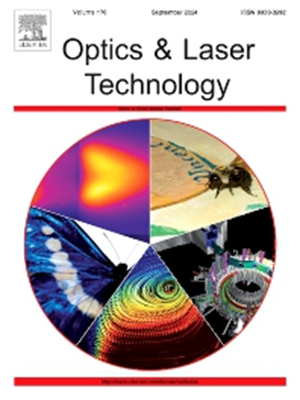Investigations on 355 nm nanosecond-picosecond dual-pulse laser enhanced ablation of carbon fiber reinforced polymer
IF 5
2区 物理与天体物理
Q1 OPTICS
引用次数: 0
Abstract
Carbon fiber reinforced polymer (CFRP) composites find extensive utilization in aerospace applications due to its exceptional structural and mechanical properties. However, the inherent characteristics of CFRP composites pose challenges for conventional machining techniques to achieve efficient and high-quality processing. This work proposed a nanosecond (ns)-picosecond (ps) dual-pulse laser processing method. A theoretical model of ns-ps double-pulse laser enhanced ablation was established. The impact of the free electron density evolution process on the energy absorption process was analyzed. The temporal and spatial distributions of temperatures in the ablation region under diverse laser irradiations were compared. The evolution mechanism of ablation morphology was thus characterized. Based on numerical simulations and experiments, the effects of time delay and pulse energy ratio on the depth and morphology of ns-ps double-pulse laser processing were determined. Through-hole processing experiments were conducted on CFRP composites with a thickness of 2 mm. The experimental results show that employing a time delay of 0 and the ps-ns pulse energy ratio of 1:4 results in a small taper. Additionally, no visible damage, such as fiber delamination or resin decomposition, was observed. Excellent through-hole quality was obtained while achieving high processing efficiency. These theoretical and experimental findings establish a robust foundation for efficient and high-quality processing of CFRP composites and other composite materials.
355nm纳-皮-秒双脉冲激光增强烧蚀碳纤维增强聚合物的研究
碳纤维增强聚合物(CFRP)复合材料以其优异的结构和力学性能在航空航天领域得到了广泛的应用。然而,CFRP复合材料的固有特性对传统的加工技术提出了挑战,以实现高效和高质量的加工。本文提出了一种纳秒-皮秒双脉冲激光加工方法。建立了ns-ps双脉冲激光增强烧蚀的理论模型。分析了自由电子密度演化过程对能量吸收过程的影响。比较了不同激光照射下烧蚀区温度的时空分布。从而表征了烧蚀形态的演化机制。通过数值模拟和实验,确定了时间延迟和脉冲能量比对ns-ps双脉冲激光加工深度和形貌的影响。对厚度为2mm的CFRP复合材料进行了通孔加工实验。实验结果表明,当延时为0,ps-ns脉冲能量比为1:4时,产生的锥度较小。此外,没有观察到明显的损伤,如纤维分层或树脂分解。在加工效率高的同时,获得了优良的通孔质量。这些理论和实验结果为高效、高质量地加工CFRP复合材料和其他复合材料奠定了坚实的基础。
本文章由计算机程序翻译,如有差异,请以英文原文为准。
求助全文
约1分钟内获得全文
求助全文
来源期刊
CiteScore
8.50
自引率
10.00%
发文量
1060
审稿时长
3.4 months
期刊介绍:
Optics & Laser Technology aims to provide a vehicle for the publication of a broad range of high quality research and review papers in those fields of scientific and engineering research appertaining to the development and application of the technology of optics and lasers. Papers describing original work in these areas are submitted to rigorous refereeing prior to acceptance for publication.
The scope of Optics & Laser Technology encompasses, but is not restricted to, the following areas:
•development in all types of lasers
•developments in optoelectronic devices and photonics
•developments in new photonics and optical concepts
•developments in conventional optics, optical instruments and components
•techniques of optical metrology, including interferometry and optical fibre sensors
•LIDAR and other non-contact optical measurement techniques, including optical methods in heat and fluid flow
•applications of lasers to materials processing, optical NDT display (including holography) and optical communication
•research and development in the field of laser safety including studies of hazards resulting from the applications of lasers (laser safety, hazards of laser fume)
•developments in optical computing and optical information processing
•developments in new optical materials
•developments in new optical characterization methods and techniques
•developments in quantum optics
•developments in light assisted micro and nanofabrication methods and techniques
•developments in nanophotonics and biophotonics
•developments in imaging processing and systems

 求助内容:
求助内容: 应助结果提醒方式:
应助结果提醒方式:


